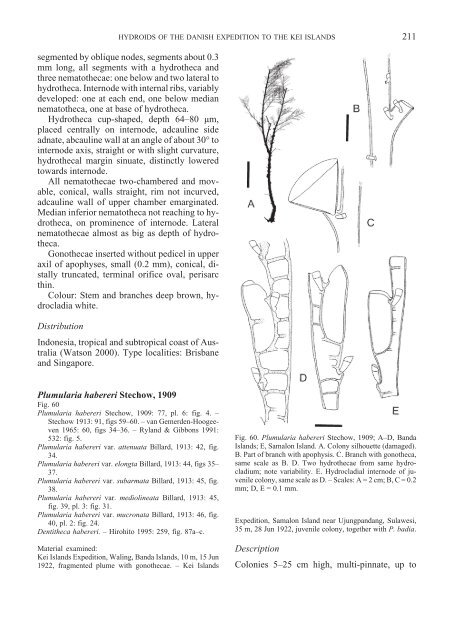Hydroids (Cnidaria, Hydrozoa) of the Danish expedition to
Hydroids (Cnidaria, Hydrozoa) of the Danish expedition to
Hydroids (Cnidaria, Hydrozoa) of the Danish expedition to
Create successful ePaper yourself
Turn your PDF publications into a flip-book with our unique Google optimized e-Paper software.
HYDROIDS OF THE DANISH EXPEDITION TO THE KEI ISLANDS<br />
segmented by oblique nodes, segments about 0.3<br />
mm long, all segments with a hydro<strong>the</strong>ca and<br />
three nema<strong>to</strong><strong>the</strong>cae: one below and two lateral <strong>to</strong><br />
hydro<strong>the</strong>ca. Internode with internal ribs, variably<br />
developed: one at each end, one below median<br />
nema<strong>to</strong><strong>the</strong>ca, one at base <strong>of</strong> hydro<strong>the</strong>ca.<br />
Hydro<strong>the</strong>ca cup-shaped, depth 64–80 µm,<br />
placed centrally on internode, adcauline side<br />
adnate, abcauline wall at an angle <strong>of</strong> about 30° <strong>to</strong><br />
internode axis, straight or with slight curvature,<br />
hydro<strong>the</strong>cal margin sinuate, distinctly lowered<br />
<strong>to</strong>wards internode.<br />
All nema<strong>to</strong><strong>the</strong>cae two-chambered and movable,<br />
conical, walls straight, rim not incurved,<br />
adcauline wall <strong>of</strong> upper chamber emarginated.<br />
Median inferior nema<strong>to</strong><strong>the</strong>ca not reaching <strong>to</strong> hydro<strong>the</strong>ca,<br />
on prominence <strong>of</strong> internode. Lateral<br />
nema<strong>to</strong><strong>the</strong>cae almost as big as depth <strong>of</strong> hydro<strong>the</strong>ca.<br />
Gono<strong>the</strong>cae inserted without pedicel in upper<br />
axil <strong>of</strong> apophyses, small (0.2 mm), conical, distally<br />
truncated, terminal orifice oval, perisarc<br />
thin.<br />
Colour: Stem and branches deep brown, hydrocladia<br />
white.<br />
Distribution<br />
Indonesia, tropical and subtropical coast <strong>of</strong> Australia<br />
(Watson 2000). Type localities: Brisbane<br />
and Singapore.<br />
Plumularia habereri Stechow, 1909<br />
Fig. 60<br />
Plumularia habereri Stechow, 1909: 77, pl. 6: fig. 4. –<br />
Stechow 1913: 91, figs 59–60. – van Gemerden-Hoogeeven<br />
1965: 60, figs 34–36. – Ryland & Gibbons 1991:<br />
532: fig. 5.<br />
Plumularia habereri var. attenuata Billard, 1913: 42, fig.<br />
34.<br />
Plumularia habereri var. elongta Billard, 1913: 44, figs 35–<br />
37.<br />
Plumularia habereri var. subarmata Billard, 1913: 45, fig.<br />
38.<br />
Plumularia habereri var. mediolineata Billard, 1913: 45,<br />
fig. 39, pl. 3: fig. 31.<br />
Plumularia habereri var. mucronata Billard, 1913: 46, fig.<br />
40, pl. 2: fig. 24.<br />
Denti<strong>the</strong>ca habereri. – Hirohi<strong>to</strong> 1995: 259, fig. 87a–c.<br />
Material examined:<br />
Kei Islands Expedition, Waling, Banda Islands, 10 m, 15 Jun<br />
1922, fragmented plume with gono<strong>the</strong>cae. – Kei Islands<br />
211<br />
Fig. 60. Plumularia habereri Stechow, 1909; A–D, Banda<br />
Islands; E, Samalon Island. A. Colony silhouette (damaged).<br />
B. Part <strong>of</strong> branch with apophysis. C. Branch with gono<strong>the</strong>ca,<br />
same scale as B. D. Two hydro<strong>the</strong>cae from same hydrocladium;<br />
note variability. E. Hydrocladial internode <strong>of</strong> juvenile<br />
colony, same scale as D. – Scales: A = 2 cm; B, C = 0.2<br />
mm; D, E = 0.1 mm.<br />
Expedition, Samalon Island near Ujungpandang, Sulawesi,<br />
35 m, 28 Jun 1922, juvenile colony, <strong>to</strong>ge<strong>the</strong>r with P. badia.<br />
Description<br />
Colonies 5–25 cm high, multi-pinnate, up <strong>to</strong>

















